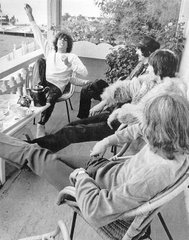It has always been a very important part of my life, this ‘Carnatic Music’. I should say it this way- It runs in the family. I don’t know if I owe this development in me, completely to my family. But yes, a part of it I have inherited from my grand old Dad’s and Mom’s, and their grand old parents. The rest of it developed because of my Mom. Not only because she is family(she isn’t into this!), but because of the gazillion times she has tried to put me in a music class, and found me back home, even before she got there. It was long after, that I actually started taking music a little seriously. I owe my Mom this entire world for having given me the opportunity to see this chapter that has opened since then.
It started growing up with me, little by little.
I was about fourteen when I actually started listening to various artistes sing, either on tapes and CD-ROMs, or on the radio. But then again, that wasn’t because I wanted to listen to them. There was music in the house all the time. You could always find songs being played and someone would always be singing along. Except for the time when we were supposed to sleep, music filled the place up. But it took some time to enter my being. It was ‘just some noise’ as I would put it to my Grandfather. To him, it was another one of his five children.
I used to think that going to ‘PAttu class’ (pAttu is the Tamil word for music, and in our context here it means Carnatic music. Yes) compulsorily for an hour every Sunday morning was a colossal waste of time and energy. Still, as me and my mates would come out after the class, we would walk back home singing the songs we sang back there, holding on to our notebooks against our chests with one hand, and clapping the other hand on the thigh putting the ThAlam, which gave a rhythmic pattern to the song. Family functions were a platform to showcase the singing prowess of the children of the family. The evenings were the time all the elders would sit in a group, and make all the children who went to music class every Sunday, sit next to them. I was one of the kids who came under this unlucky lot. Anyway, it was mandatory for each one of us to sing a song. The song was mostly the choice of one of the older people who sat there. And they criticized the performances. But the applause that followed, would set the mood for us, to not take any criticism. And then my taste for this historic genre of music, started to actualize. Still, there was music in the house all the time. Only that now, I had begun to understand it.
Attending live Carnatic music performances was what completely changed the way I looked at this culture. This whole performing group that sits on the dais has five people, and there seems to be this exchange of thought, clues, cognition, and music between them, all via subtle and compendiary eye-contacts. The ensemble of musicians consists of a vocalist, a person playing the primary instrument (violin or veena), a drone instrument (tambura, it gives pitch) performer and finally a person playing the rhythm instrument (percussion instruments-mridangam etc.). A typical concert lasts for about 3 hours or a little longer. And they are conducted in community halls or religious centres run by devotees of a particular saint. Most concerts are attended by listeners, free of cost. Various songs are sung, or played if it is an instrumental concert, and every time, it is a new, overwhelming experience. There is no introduction given about the rAgam. So finding out the rAgam after listening to the performer sing a general piece, which is basically formed by his/her imagination by combining the various notes the rAgam is constructed of, is one of the main attractions while seeing the virtuoso actually perform in front of your eyes.
Carnatic songs are sung in what are called as the ‘rAgams’. RAgams are melodic patterns. Each song is set to be sung in a particular rAgam, whereas the entire song is controlled by the rhythm given by ‘ThAlam’. ThAlams are regular beats given by the hand on the right thigh. There are about 72 parent rAgams and about 34,766 rAgams that are derived from the parent rAgams. There are 175 types of thAlams.
A live performance is different from listening to recorded music in the fact that here, you hear the music, you see it, and you get to feel it in your skin. The crowd that comes here is variegated in many aspects. There would be children from the age of 10 years, to very old men and women, who would have seen at least a few hundred concerts in all their life, and yet they come here because they know that the experience is going to be new, this time too.
So, it is the music. Everyone enjoys it in the same spirit but it transports and then leaves each one of us in a world of infinite bliss which is entirely our own.

